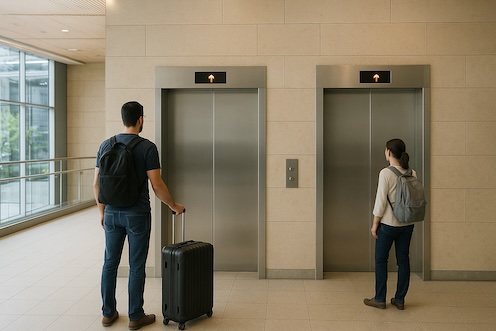The newly built transportation hub looks perfect on the blueprint:spacious waiting halls, huge electronic screens,and "high-speed elevators" symbolizing comfort. When the project manager signed the procurement contract, he firmly believed that as long as the parameters met the standards and the budget was properly controlled, the equipment could operate smoothly.
However, after only three months of trial operation, problems emerged one after another: long queues at the elevator entrance, and the piercing sound of luggage wheels rubbing against the ground; The mother with the child waited for five minutes but still couldn't get up; The elderly hesitated and some even dragged their luggage up the stairs. The facilities may seem 'advanced', but the experience is far below expectations.

Root cause: Neglecting real-life scenarios
The procurement logic only focuses on price and parameters: speed,load capacity,number of floors,etc. are all "qualified". But elevators do not operate in isolation, but carry the concentrated flow of thousands of passengers in a short period of time.
Industry surveys show that over 65% of complaints about public facility elevators are not about equipment failures, but rather about experience gaps. The weight of luggage, the space occupied by strollers and wheelchairs, and the impact of peak passenger flow have a much greater impact than paper parameters, but are often overlooked.
After sales blind spot: lack of responsibility
When the operator sought help, the supplier only replied, 'The elevator is normal and there are no malfunctions.' Queuing and congestion are not covered by the warranty. As a result, the operator had to spend extra money to upgrade the control system, hire people to maintain order, and the cost skyrocketed,damaging the reputation.
Data shows that over 40% of the operation and maintenance costs of public facility elevators during their lifecycle are due to unclear responsibilities defined in the initial contract. Focusing solely on device prices and neglecting after-sales service ultimately puts the buyer in a passive position.
Neglected "user perspective"
Elevators are not cold metal boxes, but key nodes in the flow of people. Queuing up, being late, or even missing a train has caused passengers to complain that "the new station is even more inconvenient than the old one." User experience surveys show that elevator and escalator experiences account for nearly 30% of public transportation satisfaction, and an "unqualified" elevator is enough to drag down the evaluation of the entire hub.
Expert Opinion: Whole Life Cycle Thinking
Experts point out that elevator procurement should run through the entire lifecycle:
Preliminary research: Conduct scenario simulation based on passenger flow, luggage,and special group needs.
Equipment selection: not only considering speed and load capacity, but also emphasizing group control, intelligent scheduling, and scalability.
Contract refinement: Clarify after-sales response, maintenance frequency, and emergency response to avoid gray areas.
Dynamic feedback: Continuous optimization through data and user surveys.
Although these measures increase short-term costs, they can avoid greater rework and reputation loss in the future.
Finally, it took half a year and extra budget for this transportation hub to ease the elevator problem, which also left a lesson: elevator is not a supporting role, but the core link of public experience.
In future procurement and construction, only by putting users at the center and following the lifecycle principle can elevators truly fulfill their promise of "convenient travel", rather than becoming a new congestion point.
If you would like to obtain a more detailed solution, please contact us.
